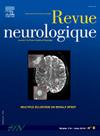Transthyretin variant cerebral amyloid angiopathy fulfilling the modified Boston criteria: Retrospective data from the Bicêtre hospital cohort
IF 2.3
4区 医学
Q2 CLINICAL NEUROLOGY
引用次数: 0
Abstract
Background
Hereditary transthyretin amyloidosis (ATTRv) is the most common hereditary amyloidosis, affecting mainly the peripheral nervous system and the heart. Central nervous system (CNS) involvement is regarded as rare, apart in some TTR variants, although leptomeningeal amyloid deposit had been described in the frequent Val30Met variant. Cerebral amyloid angiopathy (CAA) is a neurovascular disease characterized by amyloid deposits in brain vasculature, leading to ischemic and hemorrhagic events. The main cause is sporadic CAA with β-amyloid deposits but hereditary causes are possible.
Methods
We analyzed a cohort of ATTRv symptomatic patients treated at Bicêtre university hospital who underwent brain magnetic resonance imaging (MRI) regardless of indication.
Results
Twenty out of 64 ATTRv patients (31%) fulfilled radiological criteria of possible or probable CAA (suspected CAA) according to the modified Boston criteria with an unusually high 77% (10/13) frequency of leptomeningeal enhancement. Clinically, suspected CAA patients tended to have more focal central neurological symptoms, seizures and memory complaints than ATTRv patients without those MRI features.
Conclusion
ATTRv-related CAA should be considered in case of CAA with suggestive systemic features or familial history, as specific treatments and genetic counseling now exist for ATTRv. Conversely, CNS symptoms and brain MRI abnormalities should be sought in ATTRv patients.
转甲状腺素变异性脑淀粉样血管病符合修改后的波士顿标准:Bicêtre医院队列的回顾性数据。
背景:遗传性甲状腺转蛋白淀粉样变性(ATTRv)是最常见的遗传性淀粉样变性,主要累及周围神经系统和心脏。除了在一些TTR变异中,中枢神经系统(CNS)受累被认为是罕见的,尽管在常见的Val30Met变异中描述了薄脑膜淀粉样沉积。脑淀粉样血管病(CAA)是一种以淀粉样蛋白沉积于脑血管系统为特征的神经血管疾病,可导致缺血性和出血事件。主要原因是散发性CAA伴有β-淀粉样蛋白沉积,但也可能是遗传原因。方法:我们分析了一组在Bicêtre大学医院接受脑磁共振成像(MRI)治疗的有ATTRv症状的患者,无论有无指征。结果:64例ATTRv患者中有20例(31%)符合修改后的波士顿标准的可能或可能CAA(疑似CAA)的放射学标准,且薄脑膜强化频率异常高,为77%(10/13)。临床上,疑似CAA患者往往比没有这些MRI特征的ATTRv患者有更多的局灶性中枢神经系统症状、癫痫发作和记忆主诉。结论:对于具有提示全身性特征或家族史的CAA,应考虑与ATTRv相关的CAA,目前已有针对ATTRv的特异性治疗和遗传咨询。相反,在ATTRv患者中应寻求中枢神经系统症状和脑MRI异常。
本文章由计算机程序翻译,如有差异,请以英文原文为准。
求助全文
约1分钟内获得全文
求助全文
来源期刊

Revue neurologique
医学-临床神经学
CiteScore
4.80
自引率
0.00%
发文量
598
审稿时长
55 days
期刊介绍:
The first issue of the Revue Neurologique, featuring an original article by Jean-Martin Charcot, was published on February 28th, 1893. Six years later, the French Society of Neurology (SFN) adopted this journal as its official publication in the year of its foundation, 1899.
The Revue Neurologique was published throughout the 20th century without interruption and is indexed in all international databases (including Current Contents, Pubmed, Scopus). Ten annual issues provide original peer-reviewed clinical and research articles, and review articles giving up-to-date insights in all areas of neurology. The Revue Neurologique also publishes guidelines and recommendations.
The Revue Neurologique publishes original articles, brief reports, general reviews, editorials, and letters to the editor as well as correspondence concerning articles previously published in the journal in the correspondence column.
 求助内容:
求助内容: 应助结果提醒方式:
应助结果提醒方式:


